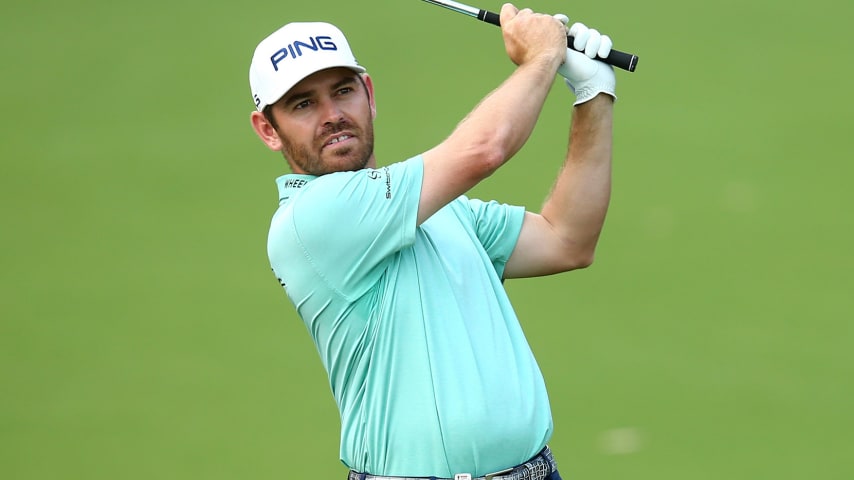Geoff Ogilvy’s seven keys to playing Royal Melbourne
6 Min Read

MELBOURNE, AUSTRALIA - DECEMBER 09: The 11th green is pictured during previews ahead of the 2019 Presidents Cup held at Royal Melbourne Golf Club on December 09, 2019 in Melbourne, Australia. (Photo by Warren Little/Getty Images)
MELBOURNE, Australia – If you want to be successful at Royal Melbourne Golf Club, you better have the keys to the sandbelt.
No, that is not some random car model from the 1970s you’ve never heard of. But it is a term you will hear a million times over at this week’s Presidents Cup.
The sandbelt is an incredible region where the golf gods set up conditions for near-perfection when it comes to golf course design. Some of the world’s best championship courses are scattered around here. Royal Melbourne is clearly one of those.
The term comes from the sandy loam soil that provides the ideal foundation for shaping a course that can boast undulating and firm greens, tight-cut greenside bunkering and all-year round playability. The courses are kind of like a hybrid between parkland and links golf.
In contrast to much of Melbourne, which is covered by heavy clay subsoil, the Melbourne sandbelt region is a geographic anomaly resulting from a prehistoric flood which deposited heavy sandstone into low lying areas. The sandy loam can reach a depth of up to 80 metres in some places.
There is no doubt this type of golf is different to what most of the globe is used to, particularly those in the U.S. So we went to International captains assistant Geoff Ogilvy – who has played Royal Melbourne more times than he can remember – to find out the seven secrets of sandbelt golf.
1. Tee shots are all about position, not distance. The big-bombing Americans will need finesse as well as brawn this week.
Says Ogilvy: “The importance of your tee shot is not about being able to get it as close as you can to the green… it is important to get yourself in a position to find the right place on the green with your next shot.
“You can’t outmuscle Royal Melbourne. Distance is valuable in some spots but sometimes it’s a 4-iron off the tee and sometimes it is a driver. Power is usually always an advantage but it is a balanced advantage here.
“You need to work out where to be by theoretically playing the hole backwards. Sometimes the rough on the correct side of the hole is better than the fairway on the wrong side of the hole. You have to find that position from the tee and that can be tough as it is very wide and the best position isn’t always obvious.”
2. You must be under the hole if you want realistic looks at birdie on these slick greens. Greens around 13 on the stimp… you better watch out.
Says Ogilvy: “The whole day at Royal Melbourne is about being under the hole for your birdie putt. This is really why the tee shot has to be positioned. If your tee shot is great, then it is exponentially easier to get it under the hole -- and if you are under the hole, it is exponentially easier to make birdie.
“You need to find the slopes where it will push the ball towards the pin, not away from the pin. If you let Royal Melbourne give you things it will, if you fight it … it will punish you every time. You can’t force it.”
3. Play to the front yardage, not the hole. Underestimate the bounce factor at your peril. If the ball looks like it’s all over the pin at Royal Melbourne, there is a good chance it won’t stay there.
Says Ogilvy: “You have to be used to landing the ball short of the hole and having it bounce up. We are so used to getting the pin number and then taking the corresponding club and just fly it to the hole on the PGA TOUR where you can stick it or spin it back.
“At Royal Melbourne, if the number is 170 [yards], you might be flying it 150. This is something all professional golfers can do but as we don’t do it as often, it is a skill you have to get back again and sharpen up in quick time.
“Firm greens are always a challenge. When you are in the rough … it isn’t chip out rough … it’s flyer rough and that takes all the control off the ball. If you send it too far then the ball hits the green and just scoots through.”
4. Remember to stay clear of the dead zones.
Says Ogilvy: “There are six or seven holes with spots that if you end up in them around the greens … you’ll be lucky to find the green at all with your chip shot or putt. Now I’m not going to give away where these all are but there are some obvious examples we’ve seen over the years where it is very difficult to get up and down. In the right place you are looking at a three or four on your card. The wrong place, it’s a six or a seven … that is the magnitude.”
While Ogilvy didn’t give up specifics ,our best guess at some obvious problem areas come early in the round on the third, fourth and fifth holes. Those greens are potentially diabolical. The 176 yard par-3 third repels balls too short and is lightning from above. The par-3 sixth is just 148 yards but miss the green and you are likely dead. Find the wrong spot on the green and prepare for a likely three-putt.
And then the par-4 fourth -- that green slopes so hard from back to front that if you are behind the pin, you are more likely to chip or putt it off the green and back down the fairway then you are to make birdie.
5. Sharpen up your bunker play. Well it is called the sandbelt after all. Australians grow up on the beach.
Says Ogilvy: “The bunkers are really tough. Firm greens mean you need to roll out your bunker shots as you won’t get a lot of spin from them. It’s a skill that is really rewarded. A lot of guys who grow up here are revered bunker players all around the world because they’ve seen it all and learned it all. Practice from the sand more than usual… and then practice some more.”
6. Find a chip and run game, with multiple clubs. You don’t always need to chip with a high loft. And even the old Texas wedge from off the green might not be the dumbest play.
Says Ogilvy: “The PGA TOUR can be very much a lob wedge tour. You get your 60 degree out when you miss the green generally speaking because that is the best club to use with the majority of setups.
“But around Royal Melbourne guys might chip with 3-irons, hybrids, 5-irons … you name it. Again this is a skill everybody has but they need to relearn it this week. The more you can have the ball on the ground the better.”
7. Take your medicine. When in trouble, find the smart play. Unless forced by an opponent’s position, the aggressive hero shot is a very small percentage option.
Says Ogilvy: “You have to think much more than usual around this sort of course. And you must remain patient. You can’t force it. You have to let it come to you with smart searching. This is certainly a place you can compound errors badly. It is a course played inside your head as much as anything else. It’s tricky and awkward so you just have to play it smart to prevail.”












